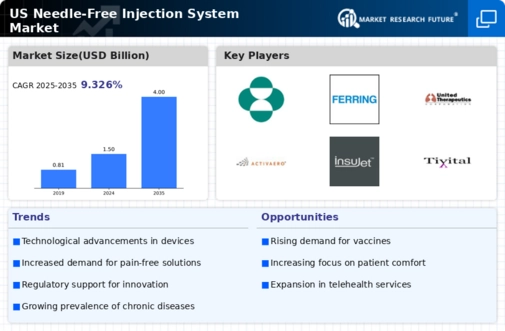Focus on Vaccination Programs
The emphasis on vaccination programs in the US is significantly impacting the needle free-injection-system market. With the increasing need for immunization against various diseases, healthcare authorities are exploring innovative delivery methods to enhance vaccination rates. Needle free injectors offer a painless and efficient alternative for administering vaccines, which could lead to higher acceptance among patients. The market for needle free vaccination systems is projected to grow substantially, as public health initiatives aim to improve immunization coverage. This focus on vaccination not only addresses immediate health concerns but also positions the needle free-injection-system market as a vital component in the broader public health strategy.
Increasing Prevalence of Chronic Diseases
The rising prevalence of chronic diseases in the US is a significant driver for the needle free-injection-system market. Conditions such as diabetes, cardiovascular diseases, and autoimmune disorders require regular medication administration, often through injections. The convenience and reduced pain associated with needle free systems make them an attractive option for patients managing chronic conditions. Reports indicate that the number of individuals diagnosed with diabetes is expected to reach 34 million by 2030, further fueling the demand for efficient drug delivery systems. Consequently, healthcare providers are likely to adopt needle free technologies to improve patient adherence to treatment regimens, thereby positively influencing the growth of the needle free-injection-system market.
Technological Innovations in Drug Delivery
Innovations in drug delivery technologies are playing a crucial role in shaping the needle free-injection-system market. The development of advanced formulations and delivery mechanisms, such as micro-needles and jet injectors, is enhancing the efficacy and safety of vaccinations and medications. For instance, the market for needle free injectors is projected to reach $3 billion by 2027, reflecting a growing acceptance of these technologies in clinical settings. These innovations not only improve the precision of drug delivery but also reduce the risk of needle-stick injuries, which is a significant concern in healthcare environments. As a result, the needle free-injection-system market is likely to benefit from ongoing research and development efforts aimed at creating more effective and user-friendly devices.
Rising Demand for Minimally Invasive Procedures
The needle free-injection-system market is experiencing a notable increase in demand due to the growing preference for minimally invasive procedures among healthcare providers and patients. This trend is driven by the desire to reduce pain and discomfort associated with traditional needle injections. According to recent data, minimally invasive techniques are projected to grow at a CAGR of approximately 10% over the next five years. As patients become more aware of the benefits of needle free systems, healthcare facilities are likely to adopt these technologies to enhance patient satisfaction and improve overall treatment outcomes. This shift towards less invasive methods is expected to significantly impact the needle free-injection-system market, as it aligns with broader healthcare trends emphasizing patient-centered care.
Regulatory Support for Innovative Medical Devices
Regulatory support for innovative medical devices is fostering growth in the needle free-injection-system market. Agencies such as the FDA are increasingly streamlining the approval process for new technologies, encouraging manufacturers to develop and introduce needle free systems. This supportive regulatory environment is crucial for bringing advanced medical devices to market more efficiently. As a result, the needle free-injection-system market is likely to see an influx of new products that meet evolving healthcare needs. The potential for faster market entry and reduced barriers to innovation may lead to a wider adoption of needle free technologies across various healthcare settings, ultimately benefiting patients and providers alike.

















Leave a Comment